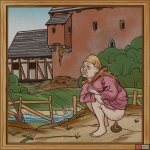Text
In the countryside or during wars, people would relieve themselves in nature, in the barn, or in the yard near the dung heap. Higher-status homesteads had a small wooden shed built near the dung heap. At night, chamber pots were used, kept under the bed, and emptied onto the dung heap in the morning.
In castles and wealthier homes, one could find a privy—a toilet, if possible, located in one of the heated rooms, in a bay window on an upper floor. It didn’t always have doors and was equipped with a seat with a round hole.
It was often located directly in the banquet hall, so the user did not have to leave the room and could observe activities at the table from the privy. Privies were typically in a niche carved into the wall, fitted with a slanted chute that opened to the outside of the building. In both cases, faeces would freely fall along the castle walls into a moat or down a slope.
Over time, privies were modernised and flushed with rainwater. Additional features were added, such as a flap that released the waste outside, which only opened when stepped on. Despite these advancements, it was still common practice until the 16th century to empty chamber pots out of windows onto the street in cities.


No Comments